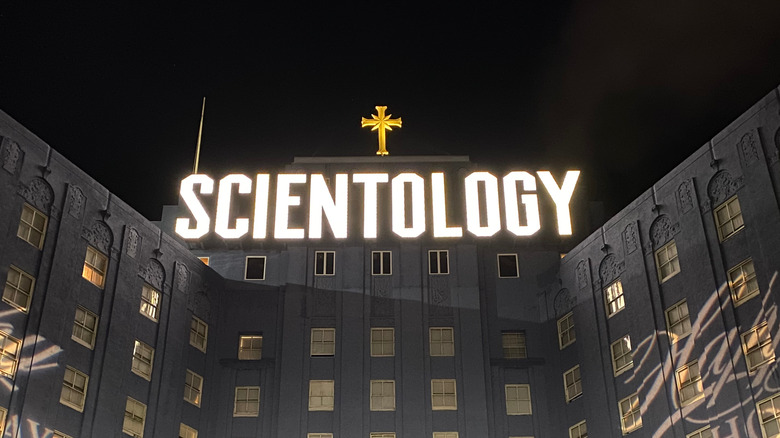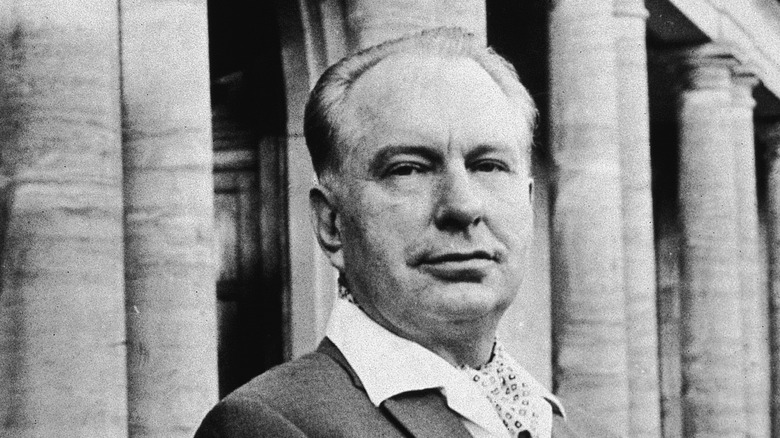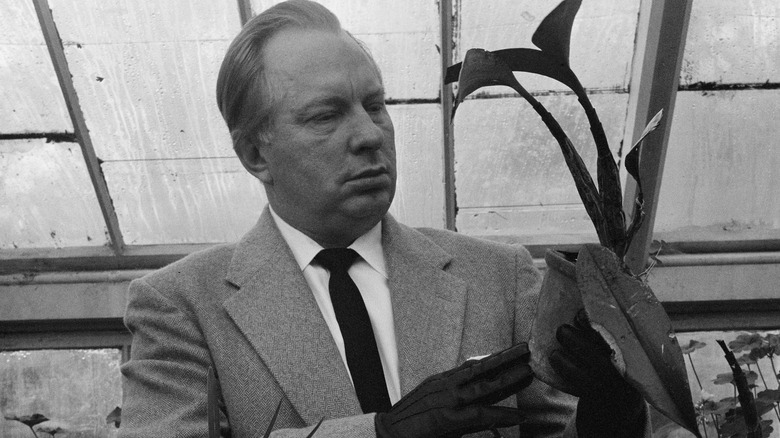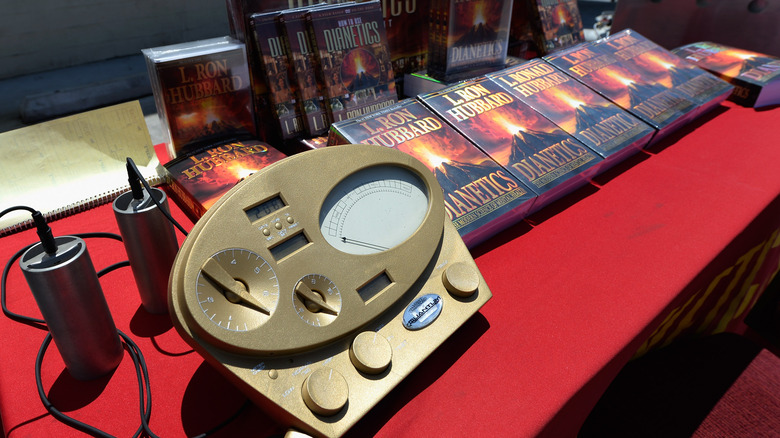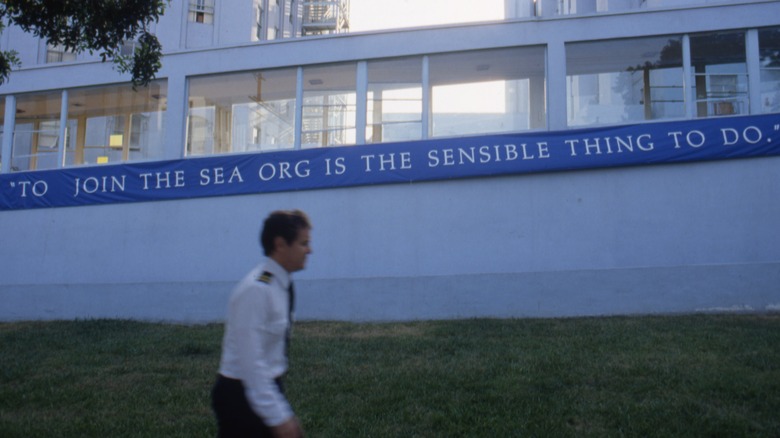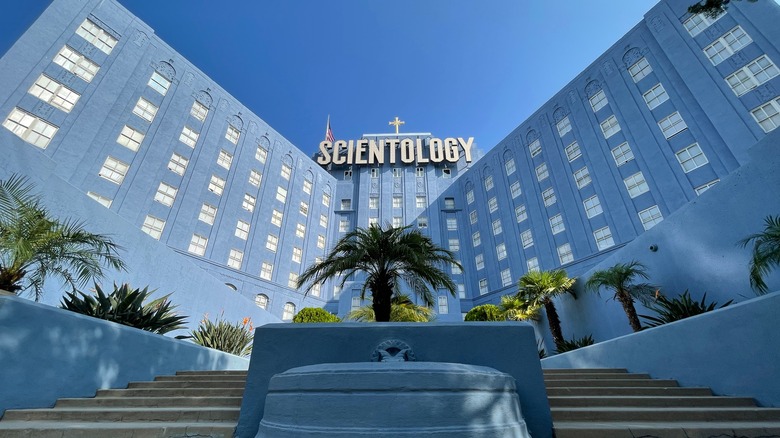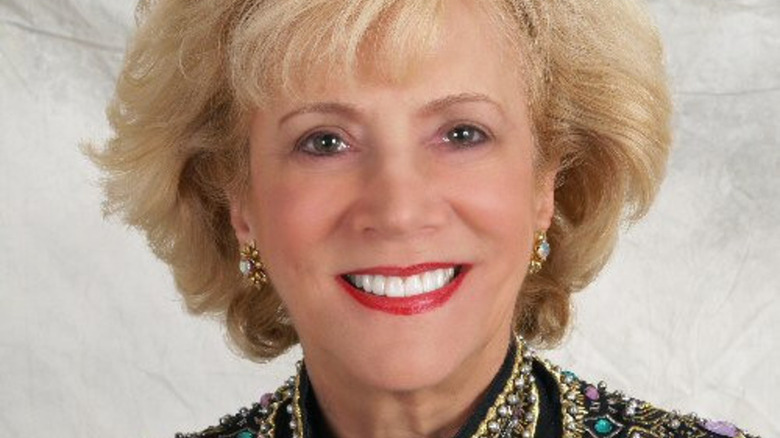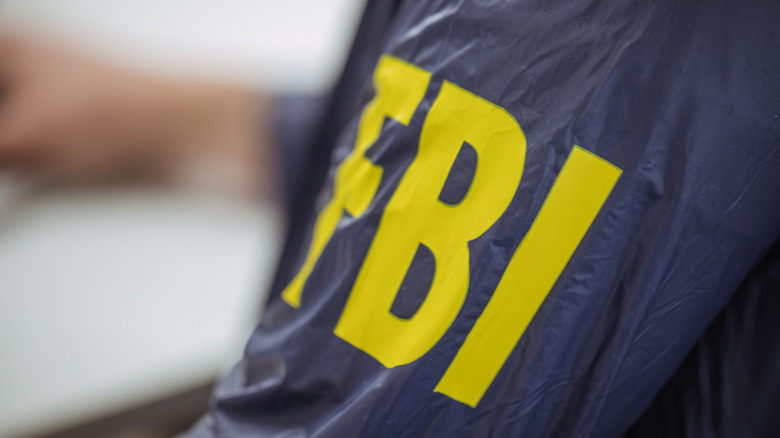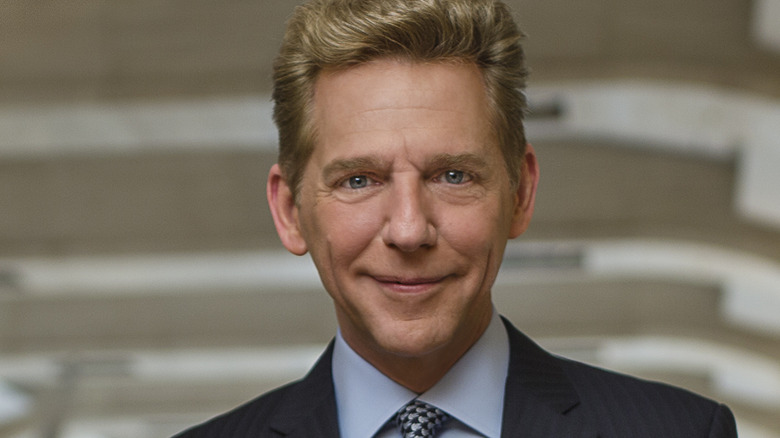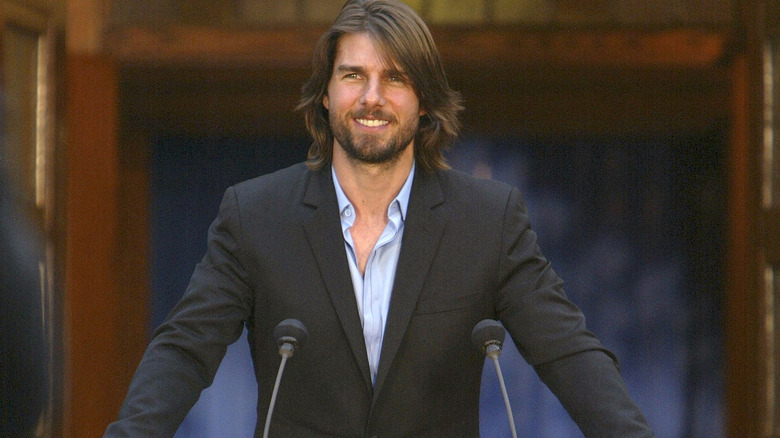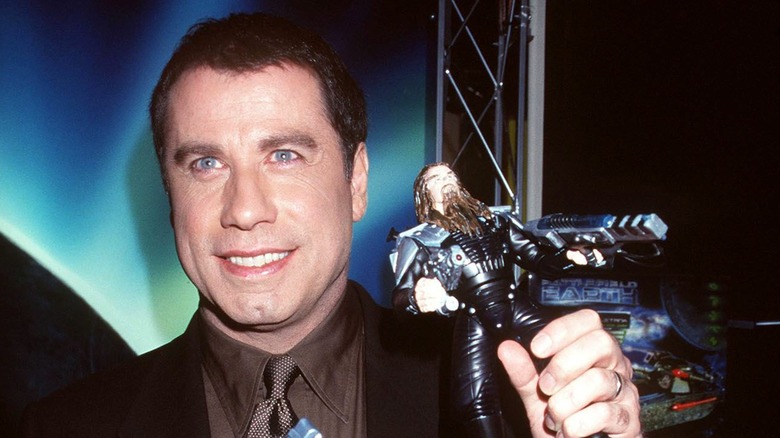The Complicated History Of Scientology
Scientology has always been highly secretive about its history, beliefs, and what life is like within the organization. Even for believers, it can take years and millions of dollars to reach the level where they are told even the fundamental beliefs of their religion. As stated by the Daily Beast, for decades Scientology has done everything it can to prevent critics from going public. The organization has used everything from lawsuits against TV shows to harassing and spying on former members to keep their secrets. Once, it even infiltrated the U.S. government in an attempt to purge all information relating to them and their notorious founder L. Ron Hubbard.
Today, despite its attempts to keep what happens inside the organization a secret, whistleblowers and former Scientologists reveal more strange and disturbing information about the Church of Scientology every year. The group's history, filled with espionage and pseudoscience, is no less bizarre.
The founder's contentious history
The most important figure in Scientology is its founder L. Ron Hubbard. Before releasing "Dianetics," the book which would become the foundation of the Church of Scientology, Hubbard was primarily known as a prolific pulp and science fiction writer. Scientology maintains that Hubbard was a war hero, but as noted by The New Yorker, his history is more complicated than that.
Hubbard claimed that he had been severely injured in World War II, and was told that he would be blind and incapacitated for life. He stated that he was able to cure himself using the techniques that he would later make the foundation of Scientology. As detailed by journalist and Scientology expert Tony Ortega, records from the time do not back up this claim. Hubbard's active service records have no mention of severe injuries, instead listing that he had mild medical issues, including an ulcer, hemorrhoids, and a possible STD. It is unlikely that Hubbard ever saw any combat while he was in the Navy, as none of the vessels he served on were ever in combat.
Before founding Scientology, Hubbard spent time studying the occult with rocket scientist Jack Parsons. The two were known to practice "sex magick" rituals together in an attempt to summon a mystical entity. As described in the biography "Strange Angel," Hubbard eventually persuaded Parsons to give him almost all of his considerable wealth. Hubbard ran off with Parsons' money and his girlfriend, Sara.
It was never supposed to be a religion
L. Ron Hubbard's book "Dianetics" was released in 1950. It would eventually become the basis of the religion known as Scientology — but Hubbard originally intended for it to be a science.
While Hubbard had no mental health or medical training of any kind, he believed that he had found the answer to mental illness. Initially, "Dianetics" was designed to be an alternative to psychiatry and the available mental health treatments in the '50s. As stated in "A war over mental health professionalism: Scientology versus psychiatry," Hubbard attempted to have "Dianetics" accepted by psychiatry and practiced as a scientific mental health treatment. The book claimed that all psychological problems were the result of "engrams" or traumatic incidents. Through a process he called "auditing," Hubbard believed a person could be fully cured of any and all diseases and mental conditions (a state Hubbard dubbed "clear").
There was no evidence that Hubbard's practices performed any of these medical miracles, and it was rejected by the medical community as a pseudoscience. Over time, Hubbard came to depict psychiatrists as evil people who intentionally try to prevent people from being clear. Without success as a science, "Dianetics" became "Scientology."
While Dianetics had been rejected as pseudoscience by some, the book was a hit. Hubbard's son has stated that his father owed millions, and for him, the easiest way to make it back was to gain followers and start a religion. The Church of Scientology was officially incorporated in 1954.
They were raided by the FDA
In 1963, Scientology was raided by the authorities, including an inspector from the FDA. To this day, Scientology maintains that this was a part of a vast conspiracy between psychiatrists and the U.S. government to oppress Scientologists. The real reason had to do with one of Hubbard's most famous inventions: the E-Meter.
As described by History, almost a decade before, Hubbard had designed a new element to assist in "auditing" their practitioners. It was a device he called an electropsychometer, better known as an E-meter. The device works similarly to a rudimentary lie detector. During sessions, Scientologists are asked a series of questions by an "auditor" while their responses are monitored on the E-meter. As described by HuffPost, these sessions are often more similar to interrogation than therapy, and all responses are documented — including embarrassing details that can potentially be used as blackmail against members who attempt to leave.
Hubbard claimed that a lot of serious chronic medical conditions, such as migraine, asthma, and arthritis, could be cured by his methods. As stated at The Underground Bunker, these claims were toned down officially once Scientology was transformed into a religion, but some Scientologists still claimed to be able to heal conditions like blindness and cancer. Regular complaints were made to the Better Business Bureau, which pressured the government to take action against Scientology.
The FDA considered the E-meter to be a fake medical device and confiscated about 100 in their raid.
Scientology runs a rehab
The official history of Scientology's drug rehab facility Narconon states that in 1966, a man who was not a Scientologist had the idea for a rehab facility based on Hubbard's teachings. In 2020, Narconon was reported to cost around $30,000. Scientology often claims that the rehabs are secular and operate independently of the rest of the organization. As noted by The Underground Bunker, internal files from Scientology that were seized by federal investigators have shown that Hubbard viewed these rehabilitations as a stealthy way of bringing people going through a vulnerable time in their lives into Scientology, while simultaneously making them look like a beneficial and charitable organization.
While Narconon presents itself as the cure for addiction, the rehab uses no proven methods of helping people. It features no counseling whatsoever and has no trained medical professionals working there. Instead, it gives patients the same introductory courses that all Scientologists are expected to do, and its methods include staying in hot saunas for a dangerous length of time and intense staring. Former patients have claimed that drug use is actually very common during the program, as is abuse, including attempts to trade drugs for sexual favors. As noted by the Hollywood Reporter, Scientology has attempted to conceal the truth about their rehabs by forging court orders that would force Google to remove links to any criticisms of Narconon.
Hubbard lived on a boat
For many years L. Ron Hubbard ran Scientology from the sea. As detailed in Russell Miller's "Bare-Faced Messiah," in 1967 Hubbard named himself commodore of a new Scientology navy, complete with naval uniforms he designed himself. His inner circle became known as the "Sea Org," a personal workforce for Scientology. When joining the Sea Org, believers would have to sign a contract promising to serve Scientology for the next billion years.
Hubbard's ship was formerly a cattle ship. It was called "Apollo," and staffed exclusively by Sea Org members. One group within the Sea Org was called "the Commodore's Messengers," and they were primarily teenage girls who worked directly for Hubbard. As detailed in The Village Voice, Hubbard released paranoia-filled orders to his crew daily. These would be delivered to the approximately 300 people on the ship. Sea Org members were also expected to write a report for Hubbard every night.
From 1967 to 1975, Hubbard remained at sea. As stated by Slate, many have viewed this as Hubbard fleeing repercussions.
Scientology created a vast criminal conspiracy to infiltrate the government
L. Ron Hubbard became increasingly paranoid over the years and more convinced that enemies were creating vast conspiracies against him. In response, Scientology would create its own conspiracy — one that would result in the largest criminal conspiracy to ever infiltrate the United States government. In 1973, L. Ron Hubbard gave this plan the code name "Snow White."
As explained by the New York Times, Hubbard wanted his followers to purge the world's governments of any files pertaining to Scientology, which he claimed were full of lies to discredit him. It was a massive project, and Hubbard's wife, Mary Sue, was in charge of overseeing it. As detailed by Time, more than 5,000 Scientologists infiltrated multiple governments, embassies, and consulates. They were employed by multiple government agencies, including the IRS, the FDA, the Treasury, and the Justice Department. These covert agents were responsible for placing secret recording devices in conference rooms, faking credentials, and stealing tens of thousands of documents.
Scientology attempted to frame a journalist
While Operation Snow White was certainly the largest covert mission to destroy people perceived as enemies of Scientology, it wasn't the only one. In 1971, a journalist named Paulette Cooper published a book called "The Scandal of Scientology," which was critical of the organization. Soon, Scientology would enact a plan dubbed Operation Freakout. As stated in a report from the New York Times, Scientology's goal was to have Cooper either sent to prison or sent to a mental institution.
As stated in a report from the Australian Broadcasting Corporation, Cooper was sued by Scientology 19 times — but Scientology didn't stop with legal attempts to silence her. Hundreds of Scientologists are believed to have been involved in the operation, which required break-ins, theft, and wiretapping. It is believed that Scientology spent millions on their attempt to discredit Cooper. They sent anonymous letters to hundreds of Cooper's family members, colleagues, and neighbors stating that she had an STD and had abused a young child, among numerous other unpleasant and false accusations. When that didn't work, they broke into Cooper's psychiatrist's office and sent her records to all of her contacts, as well. Finally, they framed her for a crime.
A bomb threat was written on some of Cooper's stationery, complete with her fingerprint. She was indicted for terrorism, and until the FBI discovered documents detailing the plans to harass and frame Cooper, it seemed very likely she would serve jail time.
The FBI raided Scientology and high-ranking Scientologists were indicted
In 1977, the FBI raided the Church of Scientology. As reported at the time by the Washington Post, more than 100 FBI agents swarmed the LA Scientology headquarters, with more searching offices in Washington. They seized documents that revealed massive files on individuals Scientology perceived as its enemies, confidential government information, and details on how Scientologists had broken into and bugged various departments as a part of Operation Snow White.
Mary Sue Hubbard had a major role in Operation Snow White and was indicted. Hubbard himself was considered a co-conspirator but was never actually charged. In 1983, Mary Sue and 10 other high-ranking Scientology officials were sent to prison.
Although Mary Sue Hubbard's role within Scientology was supposed to be for life, in 1981 she was convinced to step down for Scientology's benefit by Hubbard's young executive assistant with a hair-trigger temper: David Miscavige.
David Miscavige took control
Unlike many religious movements, Scientology has outlived its founder.
L. Ron Hubbard was last seen in 1980, in a high-security compound in the desert. As described by the LA Times, Hubbard spent the next few years in hiding due to the government's investigations into Scientology. In January of 1986, Hubbard had a stroke. Within a week, he was dead. Several days later, several high-ranking officials in Scientology held a meeting for the rest of the Sea Org. As described at The Underground Bunker, David Miscavige appeared onstage and announced that L. Ron Hubbard had voluntarily "discarded the body he had used in this lifetime" in order to move onto the next stage of Scientology research. Miscavige assured them that "the being we knew as L. Ron Hubbard still exists."
Soon Miscavige was the new leader of the Church of Scientology. Unlike Hubbard, Miscavige is styled like a clean-cut businessman. As detailed by an exposé from Vanity Fair, since he took power, many former members of Scientology have reported that Miscavige is prone to sudden violent fits of rage. He has become notorious for screaming at his subordinates, and sometimes physically assaulting them for minor transgressions.
Many outside of Scientology first heard of David Miscavige in relation to his missing wife, Shelly, who has not appeared publicly since 2005. It is believed that she is currently being held at a high-security Scientology bunker surrounded by security cameras and razor wire.
Scientology has tax exemption
For years, the IRS considered Scientology to be a business designed to bring in profit. That changed in 1993 when it was recognized as a church and given tax exemption. 10,000 Scientologists gathered for a massive rally at the Los Angeles Sports Arena to celebrate their victory. As described by a report from the New York Times, David Miscavige told the crowd, "The war is over!"
The reasons for the IRS' change of heart are more complex than Scientology being able to provide proof that it was a religious organization. In fact, it is believed that Scientology had a targeted campaign, which included lawsuits against the government agency and searching for any potentially incriminating information on IRS officials. In 1991, David Miscavige was able to walk into IRS headquarters and have a meeting with the commissioner of the Internal Revenue Service without an appointment. At that meeting, Miscavige promised that he would drop all the lawsuits against the IRS in exchange for being given tax exemption. Shortly after, an IRS special committee was formed in order to negotiate a settlement with Scientology.
In addition to giving Scientology more credibility as a religion and giving the organization grounds to accuse its critics of religious discrimination, it is believed that the tax exemption saved Scientology tens of millions of dollars.
Scientology collects celebrities
For most people, Scientology is synonymous with celebrities like Tom Cruise. This is not an accident.
Former Scientologist Amy Scobee used to be a high-ranking member of the organization who was part of the "Celebrity Centre," which recruits celebrities. According to Scobee, popular and successful celebrities serve as "walking success stories of Scientology."
Scientology notoriously shields its members from criticism of the organization, and it's unknown how much Scientology's celebrities actually know about it. Tom Cruise, the most well-known celebrity Scientologist, is close friends with David Miscavige. The two often pose for photographs, including one peculiar image featuring the two on matching motorcycles. Despite this, Scientology still goes to great lengths to hide criticism of Scientology from him.
"Scientologists are told that Tom Cruise is saving the world single-handedly, so he is considered a deity within Scientology," former member Leah Remini told the Daily Beast. Much of Cruise's life is controlled by Scientology. Former high-ranking members have stated that Scientology officials encouraged Cruise to break up with actress Nicole Kidman, wiretapping Kidman and repeatedly auditing Cruise with the intention of turning him against her. According to former members of Scientology, Cruise is also an active participant in the abuse of other members.
Bizarrely, high-ranking members of Scientology have stated that Miscavige frequently threatens to punish his subordinates by having Tom Cruise attack them, and on some occasions, the famous actor has personally punished members who have committed infractions.
Scientology's box-office bomb
The film "Battlefield Earth" was released in 2000, and became known as one of the most notoriously bad movies of all time. The film was based on L. Ron Hubbard's 1982 science fiction novel and championed by one of Scientology's most famous celebrities: John Travolta. Both Scientology and the film's director have claimed that Scientology had nothing to do with the movie, but interviews with former high-ranking officials within the organization tell a different story.
A conversation between Marty Rathbun (a former high-ranking Scientologist who became one of the organization's most outspoken critics, before being pulled back under its control) and Mike Rinder (previously Scientology's chief spokesman, now a whistleblower on Scientology's abuses) describes how involved David Miscavige really was in the film's creation. According to Rathbun, Miscavige "controlled every aspect," not only watching the raw footage from the production every day but sending corrections.
After the film bombed, Miscavige reportedly blamed the film's failure on John Travolta, apparently believing that if Travolta hadn't taken a salary (approximately 50% of how much he usually makes for a film) the money could have gone towards better special effects. Rathbun stated that he was supposed to punish Travolta for the film's dismal performance at the box office, but when the time came, he secretly chose not to bring up the film with Travolta.
Former members spoke out about abuses
Scientology is notoriously secretive, both about its beliefs and about life inside the organization. As stated by Rolling Stone, however, individuals who have escaped the influence of Scientology have spoken out about what really happens within Scientology.
Many former members, including Mike Rinder, have described how they were cut off from their families entirely after leaving the organization in a process known as "disconnection." Some, including Marty Rathbun, have exposed how members who'd fallen out of favor were subject to physical abuse.
While Scientology covets its celebrities, they are not exempt from the abuses. In 2013, actress Leah Remini left Scientology after being punished for asking about the location of her friend, Shelly Miscavige. In 2016, Remini's groundbreaking television series, "Leah Remini: Scientology and the Aftermath," premiered on A&E. On each episode, Remini and her co-host Rinder spoke to numerous former Scientologists about their harrowing experiences.
